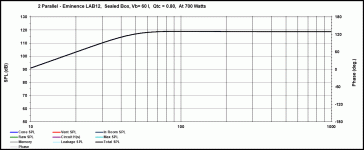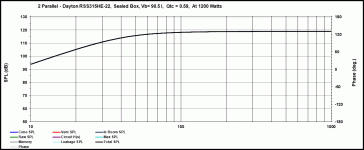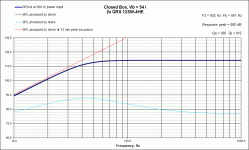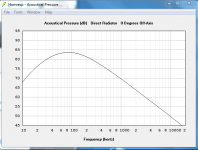I'm in the planning stage for a pair of subs to go with my upcoming DIYSG Vortex-15s. Due to the size of the Vortex I'm constrained to a pair of 14.5" wide cabinets and 12" drivers. Power will be a Crown XLS2500 already on hand, with MiniDSP 2x4 for processing and room correction. Based on this I was looking at doing dual sealed 12s, in 60-90 litres and applying Linkwitz Transform. The ability to dial in any f3 and Q appeals to me since I'm not sure what is going to work best in-room. Usage will be both music and HT, but the subs are mostly to cover the 20-40Hz range for movies.
The question I have is around drivers. I think I've narrowed it down to either the Lab-12 or the new RSS315HE-22. A parallel pair of either provides a load 2 ohms or greater across the sub range. The Labs hit xmax at about 700W input in 60L, so the amp would need to be backed off a bit. The RSS pair can take all of the power but wanted a larger box, with 90L being about as big as I can go, and they still have excursion to spare. Surprising to me, the RSS only model a couple dB higher. The main advantage of the Labs is that the box is small enough that I can go dual opposed. With the RSS both drivers would need to be front-firing, and I'm worried that even a well braced box is going to shake from the driver movement.

2xLab-12 pros:
- smaller box allows dual-opposed
- more sensitive ~103 dB at 20 Hz on 700W
- about $150 CAD lower cost for 4 and available locally
Lab 12 cons:
- xmax and thermally limited, not using full output of amp
- older design (although highly regarded)

2xRSS315HE pros:
- slightly more output ~105dB at 20 Hz on 1200W
- amp limited, excursion and thermal ratings exceed amplifier capability
- double spiders & lower distortion motor?
RSS315HE cons:
- larger box to get more out of the drivers precludes going dual opposed
- only 2 dB more output for nearly double power
- higher cost
Right now I'm leaning towards the Lab-12, based on lower cost, smaller box, and very similar output using less power. Are there other drivers I should be considering that might be better suited to this application?
The question I have is around drivers. I think I've narrowed it down to either the Lab-12 or the new RSS315HE-22. A parallel pair of either provides a load 2 ohms or greater across the sub range. The Labs hit xmax at about 700W input in 60L, so the amp would need to be backed off a bit. The RSS pair can take all of the power but wanted a larger box, with 90L being about as big as I can go, and they still have excursion to spare. Surprising to me, the RSS only model a couple dB higher. The main advantage of the Labs is that the box is small enough that I can go dual opposed. With the RSS both drivers would need to be front-firing, and I'm worried that even a well braced box is going to shake from the driver movement.

2xLab-12 pros:
- smaller box allows dual-opposed
- more sensitive ~103 dB at 20 Hz on 700W
- about $150 CAD lower cost for 4 and available locally
Lab 12 cons:
- xmax and thermally limited, not using full output of amp
- older design (although highly regarded)

2xRSS315HE pros:
- slightly more output ~105dB at 20 Hz on 1200W
- amp limited, excursion and thermal ratings exceed amplifier capability
- double spiders & lower distortion motor?
RSS315HE cons:
- larger box to get more out of the drivers precludes going dual opposed
- only 2 dB more output for nearly double power
- higher cost
Right now I'm leaning towards the Lab-12, based on lower cost, smaller box, and very similar output using less power. Are there other drivers I should be considering that might be better suited to this application?
Last edited:
You seem to have a pretty good handle on the tradeoffs involved, IMO 
Just thought I'd throw out the CSS SDX12 as an option if you haven't looked into it; I don't have one, but I see it recommended relatively often as a modern, high quality, high-excursion, (high cost) 12". I'm seeing 108db (simulated) at 20hz with two in 75l and 2000w. Here is a review of a single in a tiny sealed box: Creative Sound Solutions SDX12 12" Sealed Subwoofer DIY Kit Review | Audioholics
P.S. If you want rumours/feelings more than facts; I've heard the lab12 described as incredible in 2009; still surprisingly competitive now for dollars spent per db (in a horn, producing 40hz+) but not for density (overall volume used per db).
Just thought I'd throw out the CSS SDX12 as an option if you haven't looked into it; I don't have one, but I see it recommended relatively often as a modern, high quality, high-excursion, (high cost) 12". I'm seeing 108db (simulated) at 20hz with two in 75l and 2000w. Here is a review of a single in a tiny sealed box: Creative Sound Solutions SDX12 12" Sealed Subwoofer DIY Kit Review | Audioholics
P.S. If you want rumours/feelings more than facts; I've heard the lab12 described as incredible in 2009; still surprisingly competitive now for dollars spent per db (in a horn, producing 40hz+) but not for density (overall volume used per db).
Last edited:
hmm... have you modeled with the needed boost on the low end? It's gonna eat up some watts. I would do 2 separate boxes either way for more flexibility in placement to smooth out room response. Do you prefer sealed? You could get more output going vented. I would consider 4- RSS315HFA-8 in a pair of dual opposed or better yet 4 separate enclosures (I have mine in 50L plus about 1.5lbs of polyfill per enclosure.) In room mine will hit over 120db at 20hz with 500 watts each. Less than $800 for for 4 of these.
Matt, Maybe you saw my thread where I test most of the drivers you are asking about. A tale of 12" subwoofers, distortion and 15 dollars.
Better graphs here: Log into Facebook
I much prefer the HE over the HFA I think due to higher motor strength.
The Lab and HE measure pretty close distortion wise. The HE is more power hungry than the lab.
The lab has lower suspension losses so it should handle details in the bass better especially at low to moderate spl but I believe there are many other factors involved.
Since you mentioned space concerns you can also look into the seas l26roy it's running super clean at 31.5hz and 40 in my tests but that dayton and lab do better in the frequencies below this.
Better graphs here: Log into Facebook
I much prefer the HE over the HFA I think due to higher motor strength.
The Lab and HE measure pretty close distortion wise. The HE is more power hungry than the lab.
The lab has lower suspension losses so it should handle details in the bass better especially at low to moderate spl but I believe there are many other factors involved.
Since you mentioned space concerns you can also look into the seas l26roy it's running super clean at 31.5hz and 40 in my tests but that dayton and lab do better in the frequencies below this.
Yes, in both passive radiator and sealed ( I didn’t actually start test ported until after I tested the HF). The HE does better with dynamics like a bass drum. The HF does fine with sustained tones like a home theater rumble. I did test a 10” xxls and it did pretty well. I’d be happy to test out the 12” xls. send me a message about it.
I favour the Labs, but I admit I have a soft spot for them. I had the first 8 drivers ever to make it south of the equator and have used them in LABhorns, sealed and ported enclosures over the years. Four are going into a new build in the NY, 80L sealed, dual opposed, side firing as the bottom section of a 4 way.
Chompy said:Just thought I'd throw out the CSS SDX12 as an option if you haven't looked into it; I don't have one, but I see it recommended relatively often as a modern, high quality, high-excursion, (high cost) 12".
Thanks for this, I had not looked at the SDX12. The simulated response does look nice, however the cost is nearly double the others for only a couple db more (amp limited in my case).
mordikai said:have you modeled with the needed boost on the low end? It's gonna eat up some watts. I would do 2 separate boxes either way for more flexibility in placement to smooth out room response. Do you prefer sealed? You could get more output going vented. I would consider 4- RSS315HFA-8 in a pair of dual opposed or better yet 4 separate enclosures (I have mine in 50L plus about 1.5lbs of polyfill per enclosure.) In room mine will hit over 120db at 20hz with 500 watts each. Less than $800 for for 4 of these.
I did/have modeled the LT in WBCD. It gets a bit funny with how it normalizes to the amplifier power, since the gain gets excessive at very low frequencies and would also need a HPF. I omitted the boost from my graphs just to get an idea of the maximum theoretical output. The reason I want to go sealed is to minimize cabinet size and also to ease integration of different subs. This pair of dual 12's will join a pair of sealed single 15's (4-ohm Lab 15) that I already have. So there will be a total of 4 subs in the room. 120 dB in room at 20 Hz is very impressive though. My room is completely open on one side so I may not fare as well.
shrub0 said:Matt, Maybe you saw my thread where I test most of the drivers you are asking about.
...
I much prefer the HE over the HFA I think due to higher motor strength.
The lab has lower suspension losses so it should handle details in the bass better especially at low to moderate spl but I believe there are many other factors involved.
I had seen your thread earlier where you tested the Lab and Magnum, but somehow I missed the HE. I went back and read through the whole thing again over the last few days -- that is quite the experiment you are running! I was very interested in your comments around subjective sound vs. motor strength and other factors. It would be interesting to compare the sound of a couple subs after being EQ'd to have the same response, i.e. a more typical "sealed optimized" sub with low FS, lossy suspension and weaker motor, vs. a strong-motored driver like the Lab or Magnum. The theory says if the FR is the same, then so would be the transient response, but there are other factors in play once the input signals are no longer small.
Or compared to dual voice coil subs.
But yes the Labs I would say be a good choice.
And I am sure many feel that " Car Subs" are bad blah blah.
But having random fun with running some dual voice and single voice coil
car subs, some yielded some impressive results in small sealed boxes.
and having various 2x12 sealed boxes with cheap 12" drivers.
they can do movie rumble and gun shots pretty easily
But yes the Labs I would say be a good choice.
And I am sure many feel that " Car Subs" are bad blah blah.
But having random fun with running some dual voice and single voice coil
car subs, some yielded some impressive results in small sealed boxes.
and having various 2x12 sealed boxes with cheap 12" drivers.
they can do movie rumble and gun shots pretty easily
Last edited:
I agree in principal, the transient response should be moot as a result of the low pass filter, and resonance/ringing/overhang behaviour should be defined by the system Q. Still it seems people report subjective differences. I haven't listened to enough different drivers to have an opinion here, which is why I'm interested in others' perspectives.
Calculating the 1W "acceleration", BL/(Re^0.5 * Mms), for several of these drivers in my spreadsheet:
Lab 12C = 55.7
Lab 12 = 49.6
Magnum-12 = 48.9
RSS315HE-22 = 39.2
RSS315HFA-8 = 36.4
SDX12 = 34.7
RSS315HO-44 = 31.7
UM12-22 = 29.4
By comparison, the 4-ohm Lab 15 specs yield an acceleration value of 40.9, so by this metric at least the closest match to my existing drivers would be the HE.
Calculating the 1W "acceleration", BL/(Re^0.5 * Mms), for several of these drivers in my spreadsheet:
Lab 12C = 55.7
Lab 12 = 49.6
Magnum-12 = 48.9
RSS315HE-22 = 39.2
RSS315HFA-8 = 36.4
SDX12 = 34.7
RSS315HO-44 = 31.7
UM12-22 = 29.4
By comparison, the 4-ohm Lab 15 specs yield an acceleration value of 40.9, so by this metric at least the closest match to my existing drivers would be the HE.
People can wax lyrical for pages over differences in interconnects, so I don't give a lot of credence to subjective opinion most of the time.
As for matching drivers, I once had many subs, at one time with 4 different types and brands of drivers. Worked fine.
https://adireaudio.com/wp-content/uploads/2018/12/Adire-Audio-Woofer-Speed-by-Dan-Wiggins.pdf
From someone with patents in speaker design that makes, or at least has made, his living designing drivers.
As for matching drivers, I once had many subs, at one time with 4 different types and brands of drivers. Worked fine.
https://adireaudio.com/wp-content/uploads/2018/12/Adire-Audio-Woofer-Speed-by-Dan-Wiggins.pdf
From someone with patents in speaker design that makes, or at least has made, his living designing drivers.
Matt, I was wondering where you got your acceleration factor equation. I thought it was (Bl^2)/Re all divided by MMS.
I found drivers to be very snappy when the acceleration factor is high but if it's too high you know have a midrange driver. Another thing I found is drivers sound the most dynamic near there impedance peak. When making a playlist for a sub of songs that sound good I checked the frequency analyzer of the bass beat and it was generally close to the impedance peak.
At the impedance peak a driver will need less current for a given Spl so there will be less compression and also less distortion. This was less noticeable with the Morel however as It's coil is so big compression is a lot less across the board. However, the tradeoff with the Morel is there isn't much room for a spider so deep bass excursion is limited.
I found drivers to be very snappy when the acceleration factor is high but if it's too high you know have a midrange driver. Another thing I found is drivers sound the most dynamic near there impedance peak. When making a playlist for a sub of songs that sound good I checked the frequency analyzer of the bass beat and it was generally close to the impedance peak.
At the impedance peak a driver will need less current for a given Spl so there will be less compression and also less distortion. This was less noticeable with the Morel however as It's coil is so big compression is a lot less across the board. However, the tradeoff with the Morel is there isn't much room for a spider so deep bass excursion is limited.
Nowadays is to calc its upper mass corner [Fhm] = 2*Fs/Qts', so if wanting a 20-80 Hz BW with a 20 Hz Fs driver, then, Qts' only need be 2*20/80 = 0.5.
[Qts']: [Qts] + any added series resistance [Rs]: Calculate new Qts with Series Resistor
[Rs] = 0.5 ohm minimum for wiring, so may be higher if a super small gauge is used as a series resistor plus any added resistance from an XO/whatever.
[Qts']: [Qts] + any added series resistance [Rs]: Calculate new Qts with Series Resistor
[Rs] = 0.5 ohm minimum for wiring, so may be higher if a super small gauge is used as a series resistor plus any added resistance from an XO/whatever.
Matt, I was wondering where you got your acceleration factor equation. I thought it was (Bl^2)/Re all divided by MMS.
I started from F = m*a, and F = Bl*i.
The power P = i^2 * Re, so solving for current, i = sqrt(P/Re). For 1W input, i = 1/sqrt(Re)
Solving for acceleration,
a = F / m
= Bl i / m
= Bl / [sqrt(Re) * m]
In real life the current is determined by the complex impedance rather than Re, so for that example near that resonance peak the current and acceleration will be a lot lower. So I'm not sure if any of this is actually useful, but it was interesting to think about and compare drivers.
Any love for the GRS 12SW-4HE: GRS 12SW-4HE 12" Paper Cone Rubber Surround High Excursion Subwoofer 4 Ohm
I though they looked good for $/£50'ish per unit (first go at unibox and flying by seat of my pants tbh!)
I though they looked good for $/£50'ish per unit (first go at unibox and flying by seat of my pants tbh!)
Attachments
Last edited:
Greets!
No experience with this model, but am with this 8", which specs are so ridiculously far off that all I can say is caveat emptor/'buyer beware': Full-Range 8" Speaker Pioneer Type B20FU20-51FW
Ditto some other drivers they have so called 'accurately cloned', though couldn't find them in a quick search, so guess they're discontinued.
Also, the specs state a very high inductance, but glowing reviews that don't 'ring' true, though they were used in vehicles, so I guess OK if this is what you want it for. Ditto its frequency response that indicates much less inductance compared to Hornresp's
on axis infinite baffle [IB] sim [attached].
Re UniBox, it's supposed to plot its inductance's effect on the impedance/FR plot, so assume you didn't input it.
It also allows any added series resistance that effectively increases Qts [Qts'], so recommend at least 0.5 ohm for wiring of any sim you do.
No experience with this model, but am with this 8", which specs are so ridiculously far off that all I can say is caveat emptor/'buyer beware': Full-Range 8" Speaker Pioneer Type B20FU20-51FW
Ditto some other drivers they have so called 'accurately cloned', though couldn't find them in a quick search, so guess they're discontinued.
Also, the specs state a very high inductance, but glowing reviews that don't 'ring' true, though they were used in vehicles, so I guess OK if this is what you want it for. Ditto its frequency response that indicates much less inductance compared to Hornresp's
on axis infinite baffle [IB] sim [attached].
Re UniBox, it's supposed to plot its inductance's effect on the impedance/FR plot, so assume you didn't input it.
It also allows any added series resistance that effectively increases Qts [Qts'], so recommend at least 0.5 ohm for wiring of any sim you do.
Attachments
Ditto its frequency response that indicates much less inductance compared to Hornresp's
on axis infinite baffle [IB] sim.
edit: It actually does; late night 'whatever' didn't notice its response plot was much more stretched out than HR's, so actually very close along with its impedance plot, though again I'm leery of GRS's specs accuracy.
Any love for the GRS 12SW-4HE
If the specs are true it looks like a compelling value. The pair in 70L only lags the dual Lab 12 by about 1.5 dB. Going to quad opposed in 120L bests everything except the dual SDX12, and would be amp limited at 775W in my case. And this is at less than half the cost of dual Lab 12s.
- Home
- Loudspeakers
- Subwoofers
- Driver for dual 12" sealed

